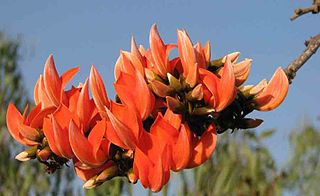
Uncaria is a genus of flowering plants in the family Rubiaceae. It has about 40 species. Their distribution is pantropical, with most species native to tropical Asia, three from Africa and the Mediterranean and two from the neotropics. They are known colloquially as gambier, cat's claw or uña de gato. The latter two names are shared with several other plants. The type species for the genus is Uncaria guianensis.

Dendrobium is a genus of mostly epiphytic and lithophytic orchids in the family Orchidaceae. It is a very large genus, containing more than 1,800 species that are found in diverse habitats throughout much of south, east and southeast Asia, including China, Japan, India, the Philippines, Indonesia, Australia, New Guinea, Vietnam and many of the islands of the Pacific. Orchids in this genus have roots that creep over the surface of trees or rocks, rarely having their roots in soil. Up to six leaves develop in a tuft at the tip of a shoot and from one to a large number of flowers are arranged along an unbranched flowering stem. Several attempts have been made to separate Dendrobium into smaller genera, but most have not been accepted by the World Checklist of Selected Plant Families.

John Stevens Henslow was an English Anglican priest, botanist and geologist. He is best remembered as friend and mentor to his pupil Charles Darwin.

Nyctanthes arbor-tristis is a species of Nyctanthes native to South Asia and Southeast Asia. It is commonly known as night-blooming jasmine, tree of sadness, tree of sorrow, coral jasmine and in Singapore seri gading. Despite its common name, the species is not a "true jasmine" and not of the genus Jasminum.
Daniel Oliver, FRS was an English botanist.

Morinda is a genus of flowering plants in the madder family, Rubiaceae. The generic name is derived from the Latin words morus "mulberry", from the appearance of the fruits, and indica, meaning "of India".

Bischofia is a genus of plants in the family Phyllanthaceae first described as a genus in 1827. It is native to southern China, the Indian Subcontinent, Queensland, New Guinea, and various islands of the Pacific. It is the only member of the tribe Bischofieae. They are dioecious, with male and female flowers on separate plants, but may rarely be monoecious.

Butea is a genus of flowering plants belonging to the pea family, Fabaceae. It includes five species native to the Indian Subcontinent, Indochina, Tibet, and southern China. It is sometimes considered to have only two species, B. monosperma and B. superba, or is expanded to include four or five.
Otto Eugen Schulz was a German botanist, born in Berlin. He was the brother of botanist Roman Schulz (1873–1926).

Gamblea is a genus of plants of the family Araliaceae, comprising four species. It originally comprised a single species, Gamblea ciliata, which is found in India.

Imperata is a small but widespread genus of tropical and subtropical grasses, commonly known as satintails.

Ludwig Adolph Timotheus Radlkofer, was a Bavarian taxonomist and botanist.
Conrad Vernon Morton was an American botanist, who did notable writings on ferns. He was also a specialist in Gesneriaceae and Solanaceae for the Smithsonian Institution from 1928.

Adina is a genus of 12 species of flowering plants in the family Rubiaceae. They are shrubs or small trees, native to East Asia and Southeast Asia.
Hornea is a monotypic genus of flowering plants belonging to the family Sapindaceae. The only species is Hornea mauritiana.
Fortunearia is a monotypic genus of flowering plants belonging to the family Hamamelidaceae. It just contains one species, Fortunearia sinensisRehder & E.H.Wilson, a shrub or tree native to southern and north-central China.
Ellisiophyllum is a monotypic genus of flowering plants belonging to the family Plantaginaceae. It contains a single species, Ellisiophyllum pinnatum(Wall. ex Benth.) Makino
Hullettia is a genus of flowering plants belonging to the family Moraceae.
Harrysmithia is a genus of flowering plants belonging to the family Apiaceae.
Hosiea is a genus of flowering plants belonging to the family Icacinaceae.









